

Distinguished U.S. Senators Join Conservancy Board
Former U.S. Senators Paul S. Sarbanes and John W. Warner have joined the Chesapeake Conservancy’s Board of Directors as honorary members.
Both Senator Sarbanes and Warner were champions of the Chesapeake Bay during their tenures representing Maryland and Virginia, respectively, in the U.S. Senate.
They led the bi-partisan efforts to advance the Bay’s restoration and to create the Capt. John Smith Chesapeake National Historic Trail and the Chesapeake Gateways and Watertrails program, among other initiatives
Charlie Stek, Chairman of the Conservancy' s Board said “I am delighted and honored that both Senators have joined our organization. They keenly understand the need to enhance recreational access to the Chesapeake and its great rivers and promote policies that help conserve land and the special places around the watershed. Their extensive experience, knowledge, and wise counsel will be invaluable to our efforts to improve public access and conserve the region’s lands, waters, and heritage.”
Blackwater Refuge Expansion Supports Trail, Conserves Habitat
The U.S. Fish and Wildlife Service has added 1,225 acres of land to the Blackwater National Wildlife Refuge, one of the premier waterfowl refuges in the Chesapeake region. The Chesapeake Conservancy helped identify the properties and advocated for their inclusion in the refuge as well as for funds to support their purchase
The 825-acre Tidelands property is located on the Nanticoke River near Vienna, MD, and is the first acquisition within the refuge’s Nanticoke Unit. The property has significant black duck habitat and is situated on the Capt. John Smith Chesapeake National Historic Trail. This conservation purchase protects approximately one mile of river frontage along the trail’s viewshed
A separate 400-acre property is located near the refuge’s southern boundary, and includes wetlands and dry forests, which provide habitat for migratory bird species including bald eagles, osprey, wood and black ducks as well as forest-dwelling, marsh and water birds. Both properties were high conservation priorities for the refuge and were acquired by The Conservation Fund.
“These are wonderful additions to the Blackwater National Wildlife Refuge and mark a terrific conservation milestone. We were pleased to partner with The Conservation Fund and USFWS to protect them,” said Joel Dunn, Executive
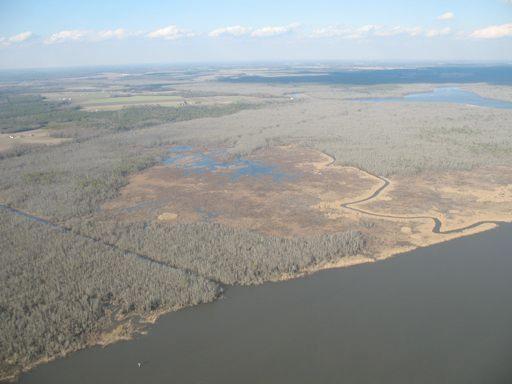
Director of the Chesapeake Conservancy. “We greatly appreciate the leadership of the Maryland Congressional delegation, particularly Sen. Barbara Mikulski and Sen. Ben Cardin, and the U.S. Fish and Wildlife Service to protect these special places on one of the Chesapeake’s great rivers.”
Blackwater refuge is one of Maryland’s premier outdoor tourist destinations and offers a variety of wildlife dependent recreational opportunities including hiking, paddling, wildlife viewing, hunting, fishing and crabbing
Funding for the acquisitions came from the Land and Water Conservation Fund (LWCF). The LWCF receives most of its revenue from the development of federally owned offshore oil and gas rights and is a critical mechanism for national investment in conservation, recreation, and historic preservation.
The Tidelands parcel is now part of the Blackwater National Wildlife Refuge on the Nanticoke River.
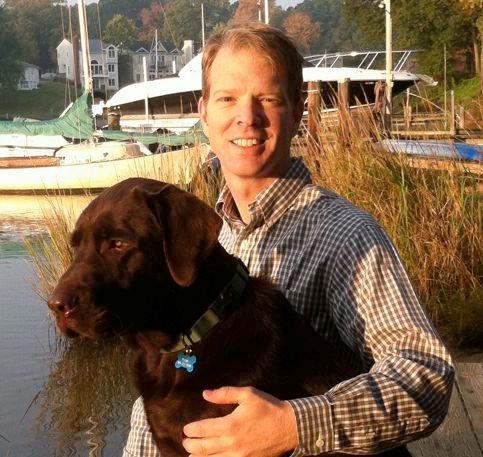
From the Executive Director
The geography of the Chesapeake naturally weaves together the land and rivers in ways that make the ecosystem and our history inseparable from our daily lives. The Bay and its rivers shape our culture and traditions, define our communities, and give us the opportunity to connect with our environment and each other.
The Chesapeake Conservancy takes pride in being a results oriented partnership builder and conservation catalyst in the effort to protect and restore the Bay. As you will see in this newsletter, we have developed strong working partnerships with Federal, State and local governments as well as numerous non-profits.
I hope our newsletter demonstrates the value of these partnerships and the Chesapeake Conservancy’s work around the Bay watershed. Please consider a contribution to the Conservancy this year. Together we can make a lasting impact by conserving the Bay’s great rivers and special places, expanding public access to our lands and waters and connecting people to the Bay’s rich heritage to inspire stewardship.
Sincerely,

Joel Dunn
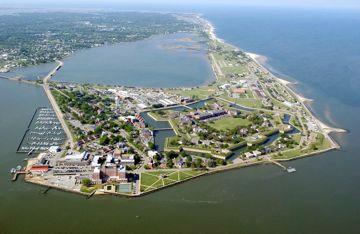
Fort Monroe: Working to Save History and Create Bay Access
The Chesapeake Conservancy’s work as a leading regional partner to have Fort Monroe named the nation’s newest National Monument may soon pay off.
“We anticipate that President Obama will name the fort a National Monument very soon,” said Charlie Stek, Chesapeake Conservancy’s Board Chairman and a leader in the effort.
The effort got a lift when Secretary of Interior Ken Salazar recently designated the Fort as part of the America’s Great Outdoors Initiative, which is President Obama’s plan to jump start community supported conservation.
Stek noted that the Virginia Congressional Delegation, Governor Robert McDonnell, state and local leaders and regional and national organizations have all collaborated to make Fort Monroe and Old Point Comfort a National Monument.
“Fort Monroe and Old Point Comfort have witnessed great national dramas Capt. John Smith and the Jamestown settlers, the arrival of African slaves and the beginning of the end of slavery, the Civil War and the Civil Rights struggle all played acts on this stage,” said Stek.
The historic fort is a key heritage site on the Capt. John Smith Chesapeake National Historic Trail, located near the mouth of the Chesapeake Bay in Hampton, VA
Stands of live oaks grace the grounds. The oldest trees were there when the English colonists stepped ashore in 1607. The beaches offer a natural refuge for the Hampton residents.
“The fort and its beaches are a national treasure, a “pearl” on the string of the Capt John Smith Chesapeake National Historic Trail and a vital part of the Chesapeake’s natural and cultural landscape,” Stek said. “As they become a part of the National Park Service they will tell our nation’s history to millions of visitors and provide much needed access to the Chesapeake Bay.”
The Conservancy helped shape the strategy to achieve monument status and has worked on the project for more than a year.
Fort Monroe was deactivated as a military institution on September 15, a result of base realignments.
Fort Monroe and its historic beaches are about to become a National Monument
Photo courtesy of Citizens for a Fort Monroe National Park
Joel Dunn and his dog Cuba
Captain John Smith Chesapeake National Historic Trail Connecting People with the Chesapeake
Along with Fort Monroe, the John Smith Trail was recently named in the Department of Interior's America’s Great Outdoors: 50-State Report as one of Virginia and Maryland’s top two conservation and recreation projects This national recognition lends tremendous support to the vision the Chesapeake Conservancy and the National Park Service (NPS) share: to bring alive the spirit of the Trail and inspire people to experience, understand, and protect its natural and cultural wonders. As the NPS’s primary partner, the Conservancy, in partnership with others, has made strides towards promoting and expanding the Trail.
Marking the Trail
The Conservancy has teamed up with the NPS, Maryland Department of Natural Resources, and Preservation Virginia to develop and install outdoor exhibits that tell the Trail’s story and encourage visitors to “Join the Adventure ” In the coming months, the first five of these
exhibits will be placed at Susquehanna State Park, Sandy Point State Park, Newtowne Neck State Park, Vienna, MD, and Historic Jamestowne. The Conservancy and the NPS plan to install more exhibits at participating locations throughout the Bay.
Captain John Smith Geotrail
This summer, the Conservancy and the NPS launched the Captain John Smith Geotrail with over 49 caches located along five rivers. Each cache, a hidden treasure to be located using a GPS device, contains a narrative about John Smith’s explorations. Families or individuals that locate over 15 caches are awarded a Captain John Smith Geocoin. Already, more than 4,200 geocachers have joined the adventure.
Connecting Trails
Using detailed river assessments completed in September 2010, the Conservancy worked with 14 partners to develop applications, supported by respective state governors, to include these river segments as connecting trails to the John Smith Trail: the Upper
Waterman’s Training Proves Popular
Forty-five watermen have successfully participated in the Waterman’s Heritage Tourism Training Program, a program initiated by the Chesapeake Conservancy in partnership with Coastal Heritage Alliance, the Maryland Watermen's Association, and the Chesapeake Bay Maritime Museum, to give watermen the opportunity to develop skills that would enable them to participate in the tourism trade as a supplement to their work on the water.
The program is funded by the Maryland Dept. of Natural Resources and the National Oceanic and Atmospheric Administration, thanks to support provided by Sen. Barbara Mikulski.
The program's third heritage tourism training workshop was held this past May in Neavitt, MD. Twenty watermen
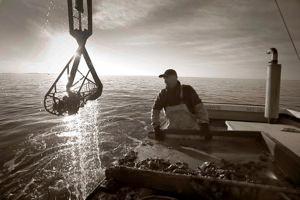
trainees participated in the three-day workshop during which eight guest presenters covered a wide variety of topics. An on-the-water component followed with John Page Williams, senior naturalist at the Chesapeake Bay Foundation, and Pete Lesher, the curator at the Chesapeake Bay Maritime Museum, providing the
James, Anacostia, Susquehanna, Upper Nanticoke, Choptank, and Chester Rivers. The National Trails System Act of 1968 authorized the designation of connecting trails to complement principal trails. The connecting trails would add 900 miles to the John Smith Trail, help tell the full story of John Smith’s voyages, and enhance the visitor experience and on-going efforts to preserve and improve the Bay.
“Smart
Buoys”
The National Oceanic and Atmospheric Administration (NOAA) launched its tenth “Smart Buoy” in partnership with the Chesapeake Conservancy. On August 17, NOAA deployed the new buoy from the deck of the Thomas Jefferson into the water near the Chesapeake Bay Bridge-Tunnel off the coast of Virginia Beach. Scientists, students, and boaters can access information from this buoy to learn about water quality and weather conditions along the John Smith Trail.
curriculum. The next workshops will be held in the Kent Island/Annapolis area.
To date, 21 participants have completed their Demonstration Experiences, the last step in the training program, during which watermen conduct actual tours with guests and are critiqued by observers. The program was designed to reach at least 60 watermen and will run through 2012.
The Conservancy has initiated planning to create a marketing coalition for the graduates of the program. State and county tourism directors have committed to supporting the program.
Watermen in Virginia have been in touch with the Conservancy, and have asked about the possibility of starting a similar program there.
Watermen are endangered icons of the Chesapeake Photo courtesy of David Hawxhurst

410 Severn Avenue, Suite 405 Annapolis, MD 21403

Talented Staff Join Chesapeake Conservancy
Within the past several months, the Chesapeake Conservancy has added to their core of expertise with the hiring of two new staff members. Joanna Ogburn has joined the organization as its new Program Director, while David Blitzer is the Chesapeake Conservancy’s new Chesapeake Fellow.
Joanna has extensive experience in stakeholder-driven conservation efforts and has focused her career on the link between public involvement and land protection. She grew up on the Chesapeake Bay in Easton, MD, and before joining the Chesapeake Conservancy ran a county-wide land conservation program in Savannah, Georgia. As the sole staff for the
Chatham County Resource Protection Commission, Joanna gained experience in all aspects of conservation. Joanna has a Masters of Environmental Management (Duke University) and a Bachelor of Science (University of Richmond).
David recently graduated from the University of Vermont with a Bachelor of Arts (double major in history and political science). Originally from the Philadelphia area, David spent his summers on his grandmother’s farm in Chestertown, MD where he developed his passion for the Chesapeake Bay. He will be working on government relations for the Chesapeake Conservancy and is looking forward to gaining valuable experience in the environmental and political arenas.

Chesapeake Conservancy Board of Directors
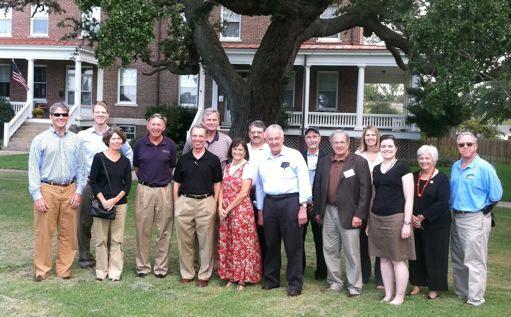
Charles A. Stek, Chairman (MD)
Patrick F. Noonan, Vice Chairman (MD)
Paul E. Hagen, Secretary (DC)
Nicholas H. Dilks, Treasurer (MD)
Stephen R. Adkins (VA)
Donald R. Baugh (MD)
Scott Beatty, Jr. (MD)
Gilbert M. Grosvenor (VA)
Page Hayhurst (VA)
Ann W. Loomis (VA)
Dr. Mamie Parker (VA)
Blaine T. Phillips, Jr. (DE)
John J. Reynolds (VA)
William H. Street (VA)
Ann P. Swanson (MD)
H.W. (Skip) Wieder, Jr. (PA)
Honorary Members
U.S. Senator John Sarbanes (MD)
U.S. Senator John Warner (VA)
Staff
Joel Dunn, Executive Director
Colleen Whitlock, Dir. of Admin.
Joanna Ogburn, Program Director
David Blitzer, Chesapeake Fellow
Board, staff and partners in front of Ft. Monroe’s historic oaks
